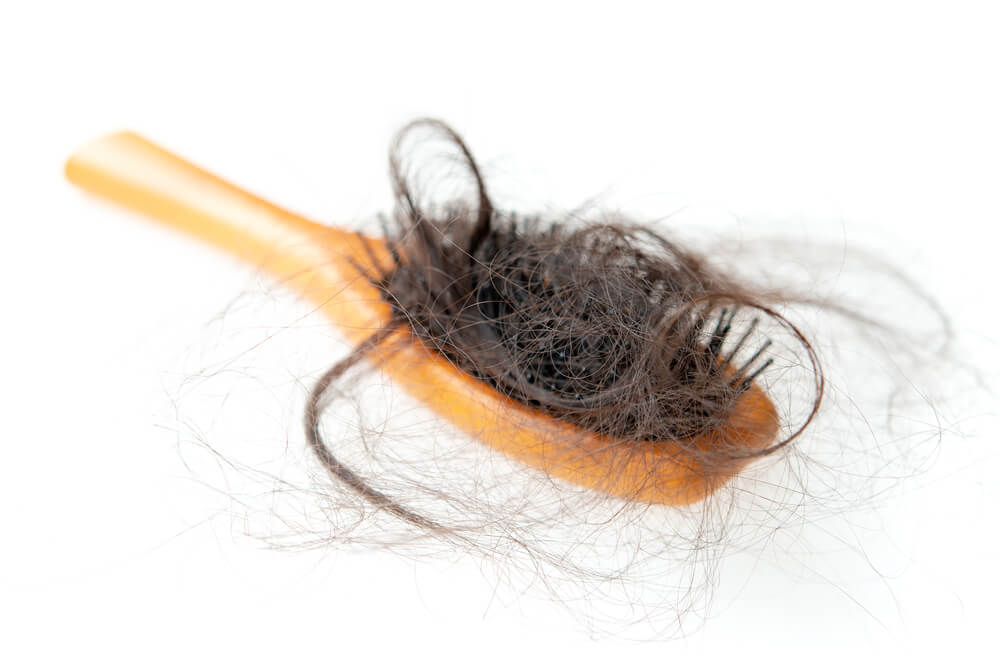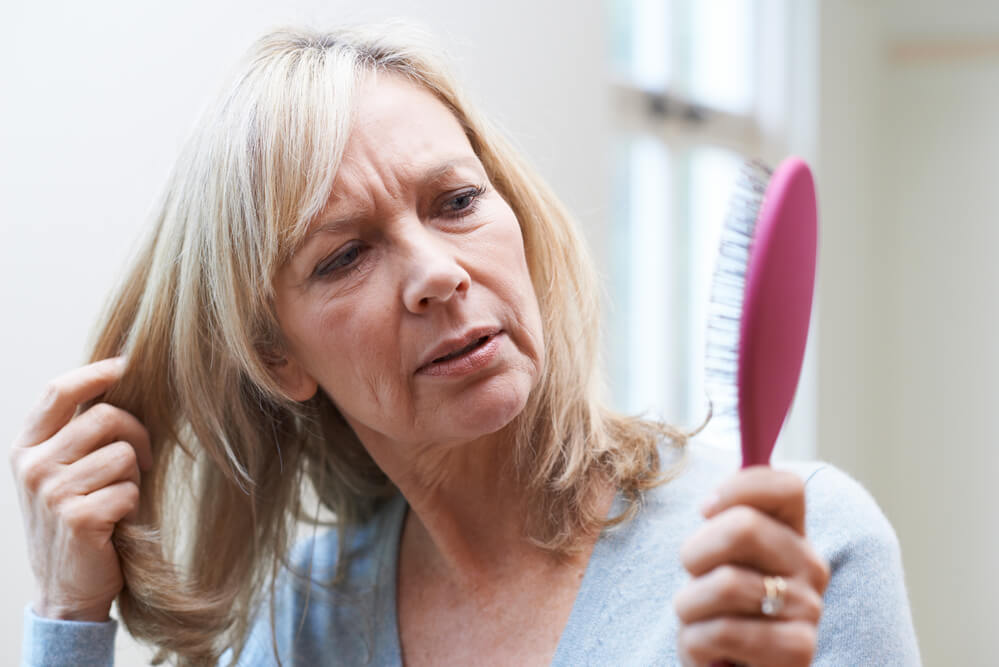Everything You Need to Know About Hair Loss in Women: Causes, Symptoms, and Treatment

The online outlet for medical information and news, MedicalNewsToday.com, cites a dermatologist who says, “Hair loss in a woman is so emotionally devastating that it can trigger a wide range of social and emotional issues that can negatively impact healthy daily living and overall quality of life.”
This is testimony to the need to understand the causes, symptoms, and treatment of hair loss to assist women who are struggling with this condition so much that they hesitate to participate in social situations because of it.
This article is for you if you are one of the more than 50 percent of women dealing with hair loss. We focus on the causes, symptoms, and treatment of hair loss. But let’s start by defining what hair loss means.
What is Hair Loss?
We all lose hair from time to time, and it’s normal to see some small strands of hair falling on your clothes or remaining on the comb. In fact, the American Academy of Dermatology Association says, “It’s normal to shed between 50 and 100 hairs a day.”
However, pronounced hair loss, also known as alopecia, is defined by the nonprofit academic medical center Mayo Clinic as “excessive hair loss from your scalp.” The same source adds, “It can be the result of heredity, hormonal changes, medical conditions or a normal part of aging.”
To understand hair loss, it’s vital to understand how hair grows. The Cleveland Clinic identifies the three cycles hair goes through from the time it is generated to the time it falls out:
- Anagen phase: this is the stage when hair is growing. It lasts between two and eight years. Between 80 and 90 percent of the hair on an average head is in this phase.
- Catagen phase: represents a period – lasting two to three weeks – characterized by the shrinking of the hair follicles (the opening in the skin through which hair grows).
- Telogen phase: the stage where the hair will fall out. It may last between two and four months.
The Cleveland Clinic also identifies three types of hair loss: anagen effluvium, caused by certain medications; telogen effluvium, resulting in an increased amount of hair falling out because follicles have reached the telogen phase; and female pattern alopecia, where hair thins on the sides and over the top of the head.
Signs of Hair Loss in Women

You will probably be able to deal with your hair loss successfully if you can identify the problem early enough. There are certain signs you can look out for to determine whether you should worry about hair loss or not.
Below, we present some of the most common signs indicating that a woman may be losing her hair much faster than would be the case if the hair was falling out naturally.
General Thinning Hair
According to the provider of health information, Healthline.com, steady thinning of hair on the top of the head is the leading sign of hair loss, affecting both men and women. The same source notes that thinning hair results in a receding hairline for men. In women, it is represented by the broadening of the part.
However, Mayo Clinic reports that receding hairlines are also increasingly becoming common for older women, a process known as frontal fibrosing alopecia.
Chunks of Hair Falling Out
Healthline.com notes that people who have just experienced physical or emotional trauma may start experiencing handfuls of hair falling out. You may notice these chunks of hair when washing or combing.
Even though this kind of hair loss may result in thinning of hair, it is usually temporary.
Complete Hair Loss
Sometimes women lose all their hair, mainly due to certain medications or treatments. If a specific medication causes hair loss, the process is known as drug-induced alopecia. This type of hair loss often affects all parts of the body.
The good news about drug-induced alopecia is that the hair grows back over time once the offending drug has been discontinued.
Patchy or Circular Bald Spots
A common sign of hair loss is alopecia areata, defined by FamilyDoctor.org as hair loss occurring in small round patches on the head.
According to FamilyDoctor.org, “A mild case of alopecia areata starts with one to two coin-sized hairless patches.” The same source notes that hair loss often stops after that.
Notwithstanding the good news that hair often grows back, FamilyDoctor.org notes that there is no guarantee: “The condition is unpredictable, and the cycle of hair loss and regrowth can repeat itself.”
The Causes of Hair Loss in Women
In an article published by WebMD.com, the online publisher of news and information relating to human health and well-being, Tammy Worth writes, “The best way to think of the way hair grows is to picture a garden.”
She adds, “How well it grows is completely a result of what is happening ‘underground.”
This means that instead of focusing on the hair being lost, it is vital to go deeper and determine the underlying causes, in the same manner, you would if your garden was not yielding the harvest you anticipated.
Below are some of the most common reasons your hair is falling out faster than it should.
It’s in Your Genes
Your hair loss could be attributable to your genes. It’s not very hard to determine whether your genes are to blame. According to WebMD.com, it’s as easy as looking at what the other members of your family look like. If they are losing their hair rapidly, then the issue is with your family genes.
WebMD.com cites the American Academy of Dermatology, which puts the number of American women losing hair because of their genes at 30 million.
The hair loss caused by genetics, aging, or hormones is sometimes referred to as female-pattern baldness or female-pattern hair loss.
Treatment
Complete hair loss is often associated with cancer; women undergoing chemotherapy often lose a lot of their hair.
Cancer.net lists some of the cancer drugs that lead to hair loss. The same source indicated that hair does not always fall out as soon as the chemotherapy starts. It often does after several cycles and weeks of treatment.
Based on information published by Cancer.net, the amount of hair you lose because of chemotherapy depends on the drug and dose. Other factors influencing the amount of hair you will lose include how you get the chemotherapy.
The amount of hair loss differs for each person, meaning that two people could take the same drug but lose different amounts of hair.
Other Causes
There are several other reasons why you may be losing your hair, including:
- Stress caused by undesirable situations like losing your job or a divorce
- Pregnancy and giving birth
- Medication or recovering from an illness
- A high fever
- Hormonal and mineral imbalance
- Age: hair loss generally becomes more prevalent after menopause
- Dramatic loss of weight, which could result from dieting or an illness
- Over-processing of hair with chemicals or styles that pull hair out of the scalp
Hair Loss Treatment
Ability to identify the symptoms of hair loss and knowing its causes is often the starting point for determining the course of treatment required.
Now that we have the basics about both, let’s look at treatment.
Sometimes No Treatment is Necessary
As you may have already noticed, hair loss can result from temporary factors such as pregnancy and the trauma of giving birth. In such cases, there is usually no need for treatment as the hair usually grows back on its own.
Watch Your Diet

If your hair loss results from the abuse of the hair through styles that pull hair too tight, the only way of reversing the damage may be to abandon the hairstyles that led to the problem.
Good nutrition and a balanced diet are essential to your overall health. To keep your hair in tip-top shape, HealthLine.com advises, “Make sure you’re including a variety of vegetables, fruits, whole grains, unsaturated fats, and lean proteins in your diet.” It adds, “Try to limit your intake of sweets.”
Here are some foods recommended by HealthLine.com:
- Foods rich in iron, like lean beef, beans, green leafy vegetables, iron-fortified grains, and eggs
- Foods rich in omega-3 fatty acids, including egg yolks, flax seeds, hemp seeds, mackerel, salmon, and walnuts.
- Foods high in protein, such as eggs, lean meats, and seafood
As any credible dietician, nutritionist, or doctor will tell you, drinking plenty of water will improve your overall health, including that of your hair.
If your condition is severe, it may be advisable to contact your doctor, who could do blood tests to determine the best treatment for your hair loss. With the correct diagnosis, a medical practitioner could determine whether you need hormonal treatment or other therapies.
Where There is No Cure, There is a Wig

Sometimes, there is no cure for thinning hair, such as when it is caused by your genes, age, or treatment. However, that doesn’t mean your head can’t still turn heads.
Techniques like the bald cap method have come to the rescue of many women affected by hair loss. The great thing about this method is that if it’s done with skill, it can easily trick anyone into believing it’s your natural hair.
Women dealing with hair loss can turn to a broad range of wigs, including clear lace wigs, single knots wigs, wet and wavy wigs, headband wigs, and colored wigs.





Hi Joan, thank you for your question. Sorry we are not familar with the salons or hair experts in Braintree Essex. So we can’t really give helpful information. Anyway, Maybe find salons on Yelp or Google My Business with good reviews would be a good start.
I am 83 years old and losing my hair I live in Braintree Essex where can get good advice buying and fitting a wig
Leave a comment